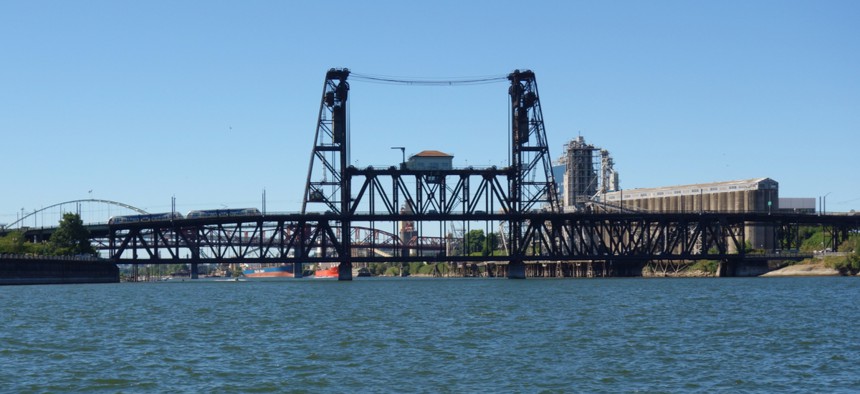This 106-Year-Old Risk Makes the Case for a Subway in Portland

The 106-year-old Steel Bridge in Portland, Oregon, is a chokepoint for the TriMet MAX light-rail system. Shutterstock
What will come first? A new river crossing Oregon's largest city needs or a massive earthquake?
If the next big magnitude 9.0 megaquake hits the Pacific Northwest, say, tomorrow, it’s expected that most of the aging bridges spanning the Willamette River in Portland, Oregon will be knocked out of commission, either by major damage or in some cases complete failure.
This seismic animation from Multnomah County from last year paints a scary picture of what could happen to the 92-year-old Burnside Bridge, its drawspans and approach viaducts, which carry a designated east-west emergency lifeline route across the river. Local officials are studying options for replacing or strengthening that bridge span in the coming years.
The next bridge north along the Willamette River is the Steel Bridge, a double-decker vertical-lift span that opened in 1912. It carries Union Pacific freight rail trains over the river in addition to street traffic and tracks that carry five MAX light-rail lines. The Steel Bridge is a critical linchpin—and choke point—for Portland’s transit system, but TriMet, the agency that operates MAX, has little direct control over the bridge’s future. TriMet is simply a tenant on the bridge, renting space from Union Pacific, which built and still owns the structure.
If the next catastrophic Cascadia Subduction Zone earthquake knocks out the Steel Bridge, it’s clearly bad news for TriMet. But it currently doesn’t take an earthquake to cripple Portland’s MAX light-rail system—routine bridge maintenance work can cause big disruptions. And TriMet knows this.
At its monthly board meeting on Wednesday, the topic of a long-term alternative to the aging bridge came up. TriMet General Manager Doug Kelsey, according to The Oregonian, said that the agency has been studying concepts for how the light-rail could possibly cross the Willamette while bypassing the existing Steel Bridge. Whatever the future solution is, it won’t be cheap—"at minimum, a $1 billion expenditure," Kelsey said during the meeting.
One of the possible solutions—tunneling under the river—would also help solve one of the biggest frustrations with the MAX light-rail service: the slow, stop-and-go slog through the central business district on surface streets that limit service. A future MAX subway crossing of the Willamette, paired with a tunnel through the heart of Portland, would cut travel times through the city and improve service for MAX routes that cross the river.
“When surface transit is at capacity & just too slow, it's time for a subway,” Jarrett Walker, the noted transit design consultant, tweeted last year when discussions of a MAX subway solution was a topic of civic discussion in Portland last year.
Such a fix isn’t a new idea. Planners in Portland have discussed it since the 1990s and they’ve been discussing it again as part of current long-range planning efforts.
A public review draft of the 2018 Regional Transportation Plan—comments are open through Monday—details the tunnel option, which would include approximately four stations between Lloyd Center, which is east of the river, and Goose Hollow, west of downtown:
The tunnel would increase system ridership by 7,500 to 15,200 riders and decrease travel time by approximately 15 minutes between Lloyd Center and Goose Hollow, while improving system resiliency and redundancy.
That long-range planning document has many other transportation priorities and there’s only so much money available to pursue them.
The big question that Portland-area officials must ask themselves: What will come first? A new seismically resilient crossing of the Willamette River or a massive earthquake that’s expected to cripple aging bridges in the city?
Michael Grass is Executive Editor of Government Executive’s Route Fifty and is based in Seattle.
NEXT STORY: Frictionless access to city, county services






